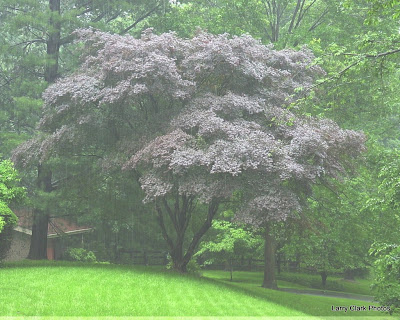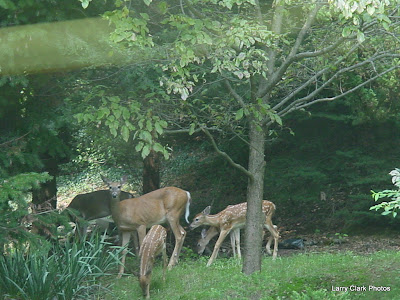I thought I'd take a break from daily happenings and post some photos of various scenes in Maryland & nearby West Virginia. Maryland has a rich history and has played an important role in the evolution of the United States.
The photo above was taken one rainy day in Colesville, MD when we lived there. The rain had let up a little and I noticed how pretty the tree next door looked. If you look closely you can see the rain drops coming down. Percy, our neighbor took great pride in his lawn and it looked great all the time. Darn him, he made me look bad.
 | |
| Burnside Bridge |
The battle of Antietam took place near Sharpsburg, MD and this bridge was an important point in the battle. The Union Army was on the left and the Confederate Army was on the right of the bridge on a bluff overlooking Antietam Creek. Rather than cross the creek at any number of places, the Union commanding officer insisted on attacking across the bridge where anyone can see, is a funnel. Many Union soldiers lost their lives there due to his stubborness.
 | ||
| Trout stream near Wolfsville, MD |
 | ||
| Old Farm house along side of the road |
 | ||||
| Brunswick, MD Railroad Station The Brunswick station was the last station in the CSX System to have a human ticket agent. |
 |
| Harpers Ferry, WV |
 |
| Shenandoah St |
 |
| Armory and gun making equipment. |
The United States Armory and Arsenal, established here in 1799, transformed Harpers Ferry from a remote village into an industrial center. Between 1801 and the outbreak of the Civil War in 1861, the Armory produced more than 600,000 muskets, rifles, and pistols, and employed, at times, over 400 workers. Inventor John H. Hall pioneered interchangeable firearms manufacture at his Rifle Works between 1820-1840, and helped lead the change from craft-based production to manufacture by machine.
On April 18, 1861, less than 24 hours after Virginia seceded from the Union, Federal soldiers set fire to the Armory and Arsenal to keep them out of Confederate hands. The Arsenal and 15,000 weapons were destroyed, but the Armory flames were extinguished and the weapons-making equipment was shipped south. When the Confederates abandoned the town two months later, they burned most of the factory buildings and blew up the railroad bridge. The first Harpers Ferry citizen killed during the Civil War was Frederick Roeder.
Gerry, Mann & Carolyn taking in the sights at Harpers Ferry, WV.
Phillip Frankel & Company was a "ready-to-wear" men's clothing store that was located in Harpers Ferry from about 1858 to 1860. A former business partner, Bernhard D. Hirsh, continued the business until about 1865 when the building burned.
John Brown's Raid John Brown believed he could free the slaves, and he selected Harpers Ferry as his starting point. Determined to seize the 100,000 weapons at the Arsenal and to use the Blue Ridge Mountains for guerrilla warfare, abolitionist Brown launched his raid on Sunday evening, October 16, 1859. His 21-man "army of liberation" seized the Armory and several other strategic points. Thirty-six hours after the raid began, with most of his men killed or wounded, Brown was captured in the Armory fire engine house (now known as "John Brown's Fort") when U.S. Marines stormed the building.
Brought to trial at nearby Charles Town, Brown was found guilty of treason, of conspiring with slaves to rebel, and murder. He was hanged on December 2, 1859. John Brown's short-lived raid failed, but his trial and execution focused the nation's attention on the moral issue of slavery and headed the country toward civil war.
One last photo was taken at our house in Colesville, MD. We lived near the Northwest Branch of Rock Creek Park and the area was overrun with deer. At first it was neat seeing them in the yard, but when we had 15-20 deer in the yard at the same time, it ceased to be that interesting. They ate every plant in our yard and it was nearly impossible to have a flower garden. We would put a spray on the plants to keep the deer away and the rain would wash off the spray and the deer would feast again. The photo below was taken from our patio which was about 50 ft from the deer.
See, I told you this would be a different blog.









I enjoyed your photos... we haven't stopped in that part of WVA yet... I used to drive from Ohio to Catonsville, MD ... through Cumberland... fairly often when our daughter lived there, but was always in a hurry to see the grandkids. So much history... we need to go back.
ReplyDelete